![]()
Thursday, October 29, 2015 | By Dr. Raz Zimmt[1]
This study is originally published by The Meir Amit Intelligence and Terrorism Information Center. The study is structured in nine sections (see below), which if read in conjunction with each other, draws a complete picture of Major General Qasem Soleimani (Haj Qasem), commander of the Iranian Islamic Revolutionary Guards Corps’ Qods Force, instigator of Iranian Subversion and Terrorism in the Middle East and around the Globe.
Soleimani’s involvement in Iraq during the American military presence
Since the beginning of the American occupation of Iraq in 2003, the Qods Force has led Iran’s collaboration with the Iraqi Shi’ite militias. Its objectives were to strengthen Iranian influence with them, support their campaign against the United States and the international coalition forces and to establish Iranian influence over the Iraqi leadership.
As part of Iranian involvement in Iraq the Qods Force provided most of the Shi’ite militias[6] with money, equipment and weapons. The Qods Force also coordinated and organized sending Hezbollah operatives to Iraq to support the fighting against the United States. The weapons the Qods Force supplied the Shi’ite militias, especially powerful explosive devices, killed many American and other coalition forces soldiers. At the end of 2006 and the beginning of 2007 the American forces arrested Iranian operatives, among them Qods Force operatives in Iraq, for their involvement in subversion and terrorism in Iraq.
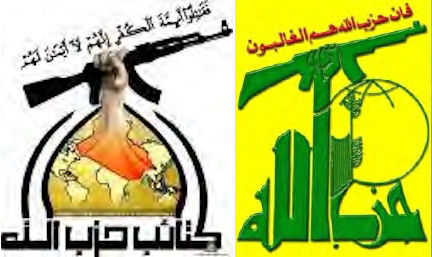
Left: The logo of the Hezbollah Battalions Shi’ite militia. Right: the logo of Hezbollah in Lebanon. The Arabic is a Qur’an verse reading “Fight the imams of apostasy, for they have no faith.” The similarity between the two logos is striking.
Qods Force activity in Iraq during the American military presence was orchestrated by a regional command called the Iraq Corps (or Ramadan Corps). It directed Iranian activities inside Iraq, especially commanding the Shi’ite militias operating under Iranian influence. In addition, the Iranians also engaged in political subversion in the internal Iraqi arena. One of the Wikileaks documents exposed a communiqué from the American embassy in Baghdad sent on November 13, 2009, which described Iran’s efforts to manipulate the Iraqi elections, and detailed Qasem Soleimani’s capabilities in the Iraqi arena.[7]
Qasem Soleimani’s involvement in the anti-ISIS campaign
ISIS’s dramatic military successes in Iraq, especially in the summer of 2014, posed a serious strategic challenge for Iran. At the beginning of June 2014 ISIS occupied most of the city of Mosul in northern Iraq. ISIS’s takeover of broad swaths of Iraq jeopardized its territorial integrity, worsened the Sunni-Shi’ite rift and positioned a hostile, violent organization on Iran’s border. That forced Iran to dispatch arms and advisors to Iraq under the command of Qasem Soleimani, who directed the Iraqi military campaign fought by Iranian-supported Shi’ite militias in coordination with the Iraqi regime.
During the past year the social networks and Iranian media posted dozens of pictures and videos documenting Soleimani’s activity in Iraq (despite the fact that his presence in Iraq was formally denied by Iran until the summer of 2014). The pictures prove Soleimani was often in Iraq, accompanied by commanders and fighters of the Iranian-supported Shi’ite militias. Soleimani, who until then had preferred to work behind the scenes, entered the limelight.
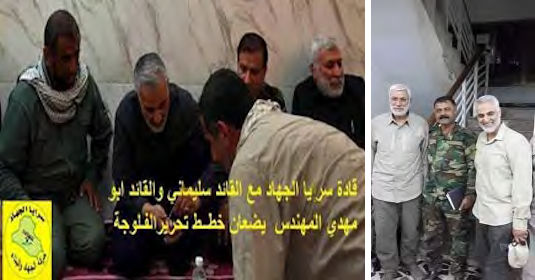
Left: Qasem Soleimani meets with the commanders of the Jihad Companies militia and Jamal al-Ibrahimi, commander of the Hezbollah Battalions (Facebook, June 17, 2015). Right: Qasem Soleimani and Jamal al-Ibrahimi (aka Abu Mahdi the Engineer), (Qasemsoleimani.ir, June 7, 2015).
In the wake of ISIS’s military successes in Iraq, beginning in the summer of 2014 Soleimani’s involvement in the various battle zones in Iraq increased significantly. During the past year, until the recent Syrian army offensive in the north, he devoted most of his time and energy to halting the spread of ISIS in Iraq. To that end he paid frequent visits to Iraq, led campaign planning and the transfer of military support and intelligence from Iran to Iraq, coordinated the joint fighting of the Iraqi army and the Shi’ite militias fighting under IRGC aegis and was in constant contact with senior Iraqi officials in the central government in Baghdad and the Kurdish leadership in northern Iraq.
ISIS’s occupation of Mosul triggered the intensification of Soleimani’s involvement in Iraq. According to a report broadcast on Hezbollah’s Al-Manar TV, a few hours after ISIS occupied Mosul Soleimani landed in Baghdad, accompanied by Iranian and Hezbollah military advisors. Meeting with senior Iraqi regime officials, he formulated a strategy of Iraqi army and Shi’ite militia collaboration for the defense of Baghdad and its environs to prevent further ISIS advances. Soleimani ordered the securing of the road between Baghdad and Samarra, which lies 125 kilometers (78 miles) to the northwest. He also commanded the battles against ISIS along the road leading to Baghdad and in Al-Anbar Province in western Iraq (Lebanese news website Naharnet, November 29, 2015). In retrospect, it can be said that the impetus of ISIS’s expansion in Iraq was halted after its successes in the summer of 2014. However, despite American and Iranian support, the Iraqi army and the Shi’ite militias could not restore the status quo ante.
Senior Iraqi army personnel also gave Soleimani credit for planning the liberation of the ISIS-occupied city of Jurf al-Sakher, which lies 50 kilometers (30 miles) south of Baghdad, as part of Operation Ashura (October 2014). According to Iraqi Shi’ite militia commanders, Soleimani was on the front lines and oversaw the training of thousands of Iraqi fighters. He also coordinated with Iraqi army commanders before the operation, whose objective was to prevent ISIS from advancing towards the cities of Najaf and Karbala, both sacred to Shi’a Islam (Fars News, November 12, 2014). Fears ISIS would make such inroads have not been realized so far and the fighting in Iraq has not yet reached regions sacred to Shi’a Islam.
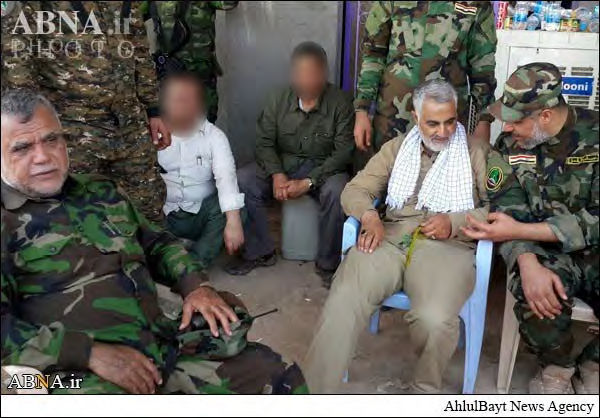
Qasem Soleimani with senior Asa’ib Ahl al-Haqq militia fighters after the reoccupation of Jurf al-Sakher (ABNA, November 10, 2014)
At the beginning of March 2015 Soleimani went to the Salah al-Din Province north of Baghdad to oversee the fighting of more than 25,000 Iraqi army soldiers and Shi’ite militiamen, who fought successfully to liberate the Sunni city of Tikrit, the provincial capital (occupied by ISIS in June 2014). Soleimani had conducted the campaign in conjunction with the commanders of Iranian-sponsored Shi’ite militias during the time of the American presence in Iraq. The commanders were Hadi al-Ameri, commander of the Badr Forces; Qays al-Khazaeli, commander of the Asa’ib Ahl al-Haqq; and Abu-Mahdi al-Muhandis, commander of the Hezbollah Battalions in Iraq (Fars News, March 2, 2015). The reoccupation of Tikrit in June 2015 was assisted by aerial support from the American-led international coalition. That support, which illustrated the limits of the Iraqi army and the Iranian-supported Shi’ite militias, came in response to a request from the Iraqi government, in view of the difficulties experienced by the Qods Force-supported Iraqi forces in expelling ISIS from Tikrit.
On October 24, 2015, Iraqi Prime Minister Haider al-Abadi announced the liberation of the oil city of Baiji after seven months of fighting. The Iraqi army issued a similar announcement. Iraqi TV broadcast pictures of the Iraqi army in the center of the city (which was in ruins). If the Iraqi army gains control of Baiji, the refineries and surrounding areas, it will be an important achievement for both the army and the Iranians. It will also mean more prestige for Soleimani, who follows events in Iraq even as he manages the Syrian arena. The Iraqi army is aided by Shi’ite militias supported by the Qods Force, and in the region of Baiji there are Iranian advisors who helped the Iraqi army occupy the city (Al-Hadath News, October 13, 2015). On October 13, 2015, before the reports of the liberation of Baiji, the Lebanese newspaper Al-Akhbar reported that Soleimani had recently paid a visit to the city, apparently to coordinate the campaign for its liberation from ISIS.
Soleimani’s contacts with other power centers in Iraq
In his efforts to halt ISIS’s progress in Iraq, Soleimani did not deal only with the central government in Baghdad and the Shi’ite militias. He also extended his contacts to the Kurdish leadership in northern Iraq. In July 2015 he met in the city of Irbil with Masoud Barzani, the president of the Kurdish Autonomous Region in Iraq. Barzani thanked him for Iran’s support of Iraq in its war against ISIS, and Soleimani told him that the nuclear agreement signed in the middle of July between Iran and the Western powers would not change Iran’s regional policies (Asr-e Iran, July 22, 2015).
A few weeks later the Kurdish media reported Soleimani had visited Iraqi Kurdistan again, and had met with senior Kurdish leaders. A source in the political bureau of Patriotic Union of Kurdistan (PUK) reported that Soleimani had met with senior PUK officials and advised them to avoid internal struggles and focus their efforts on fighting ISIS (Fars News, August 5, 2015).
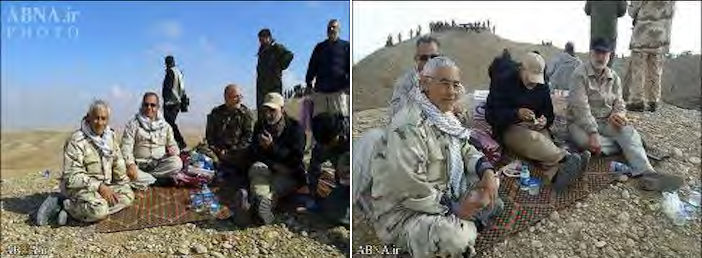
Qasem Soleimani in the town of Jalawla, in northeastern Iran, November 2014 (Sahebkhabar.ir, November 26, 2014)
In recent months Soleimani also tried to convince the Sunni tribal chiefs in Iraq to join the fighting against ISIS. In June 2015 the social networks posted a video of Soleimani meeting with Sunni tribal chiefs in Al-Anbar Province to convince them to fight alongside the Shi’ite militias. There was also a report that a delegation of fourteen Sunni tribal chiefs had gone to Iran to ask for money and weapons to fight ISIS. According to the report, Iran said it would grant the request, but on the conditions that the money and weapons be sent via the Iraqi government (Fars News, June 23, 2015). So far, Soleimani’s efforts to enlist the Sunni tribes have not succeeded, in large measure because of Iraqi government policies that pushed them into the arms of ISIS.
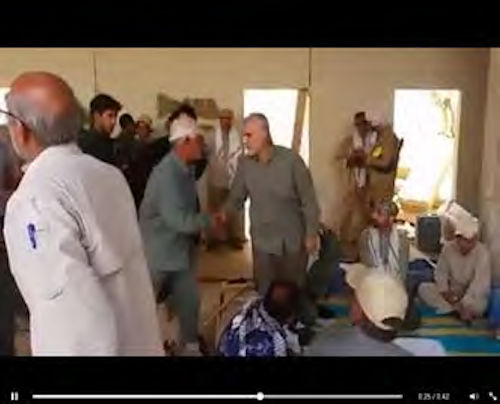
Qasem Soleimani meets with Sunni tribal chiefs in Al-Anbar Province (www.facebook.com/IRGCSF?fref=photo, June 9, 2015)
Qasem Soleimani has publicly expressed his confidence that ISIS can be defeated. He has said that Iran is the only country operating against ISIS and accused the United States of not only not doing anything to support the anti-ISIS campaign, but of supporting radical Sunni organizations. After the city of Ramadi fell to ISIS in May 2015, Soleimani claimed that the American forces stationed at the air force base at Ain al-Asad, near Ramadi, had done nothing to halt ISIS’s advance towards the city (IRNA, May 25, 2015). In view of the poor performance of the Iraqi army during the past year, Soleimani’s declarations seem overly optimistic, since the Iraqi army and the Shi’ite militias have so far not had any significant successes in fighting ISIS.
Tension and disagreements between Soleimani and the Iraqi leadership
Qasem Soleimani’s contribution to the campaign against ISIS gained him respect and admiration from several senior Iraqi officials. For example in August 2015, Imad al-Hakim, the chairman of the Supreme Islamic Council of Iraq, said that without Soleimani’s support of Iraq it would not have acquired its current capabilities in the struggle against ISIS (Abna News, August 18, 2015). Qasem al-Araji, a member of the Iraqi parliament, even proposed erecting a statue of Soleimani in Iraq in appreciation for his struggle against ISIS (Qasemsoleimani.ir).
However, Soleimani’s involvement in directing the campaign against ISIS, and especially his intervention in Iraq’s internal affairs, led to disagreements between him and the central Iraqi government. In recent months there have been reports of the Shi’ite Iraqi political and religious leadership’s growing reservations of Iran’s increasing influence in the country, especially opposition to Soleimani’s personal intervention in internal affairs. The reservations stem from Iraq’s genuine desire not to turn into an Iranian satellite, its fundamental desire to continue receiving American aid in the campaign against ISIS and its desire to preserve correct relations with the Sunni Arab world.
The tensions came to the fore in the political confrontation that developed in the summer of 2015 between Haider al-Abadi, the current Iraqi prime minister, and Nouri al-Maliki, the former prime minister. In August 2015 the Iraqi media reported that Soleimani had been sent to Baghdad to convince the Iraqi government not to remove al-Maliki from his post as deputy president and put him on trial, after the Iraqi parliament announced the initiation of a parliamentary investigation of his responsibility for the fall of Mosul to ISIS in the summer of 2014 and on charges of involvement in corruption (Okaz, August 17, 2015).
In September 2015 there were a number of reports in the Arab press about a serious dispute between Prime Minister al-Abadi and Qasem Soleimani. On September 12, 2015 the Lebanese daily Al-Nahar reported there had been two serious incidents during August 2015:
- The first took place after al-Abadi instructed the Iraqi security forces to conduct a search of Iranian planes in the Baghdad airport and examine the cargoes to prevent the transfer of arms to the Syrian regime and the Shi’ite militias in Iraq.
- The second took place in the middle of August 2015 during a meeting al-Abadi held with al-Maliki and other senior Iraqi officials after al-Maliki had returned from a visit to Tehran. Soleimani was also present at the meeting, and criticized the political reforms proposed by al-Abadi in the wake of public protest over corruption. Al-Abadi strongly criticized Soleimani, asking if he was speaking on behalf of the Iranian government or expressing his own personal opinions. Soleimani told him that he was speaking as the advisor to the popular Iraqi militias. Al-Abadi answered that he himself made decisions that expressed the will of the Iraqi people and the Shi’ite religious leadership in Najaf. He said there was no justification for Soleimani’s presence at the meeting, at which point Soleimani left.
On September 22, 2015, the London-based Saudi Arabia-affiliated daily newspaper Al-Sharq Al-Awsat reported another incident between Soleimani and al-Abadi. It occurred in Basra, when al-Abadi met a convoy of official vehicles going towards the Baghdad airport. When he asked whose vehicles they were, he was told they would be used by Soleimani, who was supposed to arrive in Baghdad for a meeting with Abu-Mahdi al-Muhandis, the commander of the Hezbollah Battalions Shi’ite militia. Al-Abadi became angry and instructed the convoy to be stopped. According to the source of the report, whose reliability has not been verified, al-Abadi said that if Soleimani wanted to hold an official visit in Iraq, he had to inform the authorities, and if he wanted to hold a private visit, he had to ask for a visa. According to the paper, because of the disagreements between al-Abadi and Soleimani, al-Abadi was becoming increasingly concerned about possible attempts to assassinate him.
Reservations about Qasem Soleimani’s activity in Iraq have not been limited to the political leadership. For example, the senior Shi’ite cleric Ayatollah Ali Sistani, considered the highest Shi’ite authority in Iraq, expressed concern over Soleimani’s increasing intervention in Iraqi politics. On September 7, 2015, an Iraqi politician told Al-Sharq Al-Awsat that Sistani had recently sent a letter to Iranian Supreme Leader Ali Khamenei, asking if Soleimani’s political involvement was a private initiative or undertaken on instructions from the supreme leader.
The closer Soleimani’s relations with the Shi’ite militias in Iraq become, the more internal Iraqi criticism of him there is. The Iraqis claim he provokes the widening of the serious sectarian rift between Shi’ites and Sunnis in Iraq. That is significant for the campaign against ISIS, because it forces the Sunni population into the arms of ISIS and makes it difficult to recruit them.
In September 2014 several Sunni members of the Iraqi parliament demanded to summon Sa’dun al-Dulaymi, the Iraqi minister of defense, to the parliament, to explain the role the Iranian forces played in liberating the city of Amirli, in the Salah al-Din Province from ISIS in August 2015. They claimed that the presence of Soleimani in Iraq was, a gross violation of Iraqi sovereignty. The demand was made after pictures of Soleimani were published showing him in the suburbs of Amirli wearing a uniform and accompanied by Shi’ite militia fighters. Khaled al-Dulaymi, a Sunni member of parliament, said that Soleimani’s presence in uniform in an Iraqi city reinforced Sunni concerns about an organized campaign led by the central administration in Baghdad and Iran against the Sunnis in Iraq (Al-Araby Al-Jadeed, September 5, 2015).
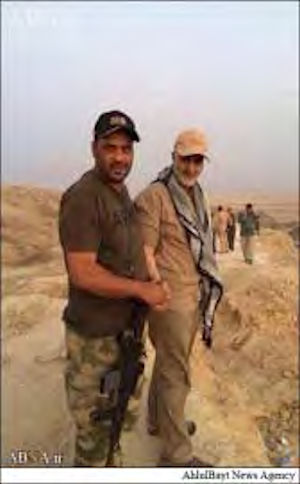
Qasem Soleimani in the city of Amirli in September 2014. He was accused of violating Iraqi sovereignty (Abna News, November 10, 2014).
Apparently criticism of Qasem Soleimani’s conduct was not limited to Iraq and was joined by Iranian officials, as well. In the summer of 2014 the media issued several reports claiming the Iranian leadership had decided to remove Soleimani from his position as responsible for the Iranian campaign in Iraq because of ISIS’s successes and Soleimani’s failure to ensure Nouri al-Maliki would be reelected as Iraqi prime minister. The reports turned out to be false and Soleimani even increased his involvement in directing the fighting in Iraq, but it is probable that they indicated criticism in certain forums in Iran of his conduct.
In recent months there has been a significant reduction in Iranian media exposure of Soleimani’s activities in Iraq, again raising speculations that his performance has been unsatisfactory. That can be explained by the ongoing fighting in Iraq against ISIS, which has not been decisive, and the diverting of IRGC and Hezbollah resources from Iraq to Syria. On September 5, 2015, the British Economist quoted a source claiming that the objective of the return of former IRGC Commander Mohsen Rezaei to its ranks was to supervise Soleimani.
![]()
You can find the introduction and other sections here:
- Introduction: Portrait of Qasem Soleimani, commander of the Iranian Islamic Revolutionary Guards Corps’ Qods Force
- Section 1: A short biography of Qasem Soleimani
- Section 2: Qasem Soleimani’s involvement in the Syrian civil war
- Section 4: Qasem Soleimani’s involvement in the Palestinian arena and Israel
- Section 5: Qasem Soleimani’s involvement in Lebanon
- Section 6: Qasem Soleimani’s involvement in Yemen and other Middle Eastern states
- Section 7: Qasem Soleimani’s involvement in internal Iranian politics
- Section 8: Qasem Soleimani’s public image
- Section 9: Possible lifting of international sanctions on Qasem Soleimani in the wake of the nuclear agreement
![]()
Notes:
[1] This study of Qasem Soleimani was written for the Intelligence and Terrorism Information Center (ITIC) by Dr. Raz Zimmt, a research fellow in the Alliance Center for Iranian Studies in Tel Aviv University and a research fellow at the Forum for Regional Thinking. His fields of expertise include the politics, society, foreign policy and social networks in the Islamic Republic. The study was coordinated with ITIC research fellows and includes information previously appearing in ITIC publications about the Qods Force.
[6] Among the Shi’ite militias cultivated by the Qods Force, the largest were the Hezbollah Battalions (Ktaab Hezbollah), the League of the People of Truth (Asa’ib Ahl al-Haqq) and the Promised Day Brigade (Liwa al-Youm al-Mawud), with several thousand operatives.
[7] Guardian.co.uk, December 4, 2010.



 RSS
RSS




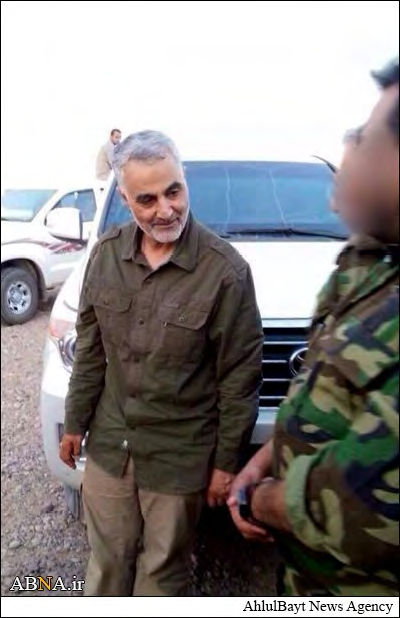
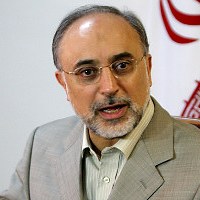
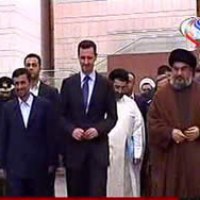
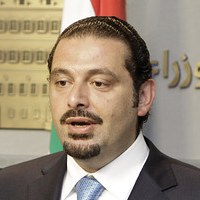

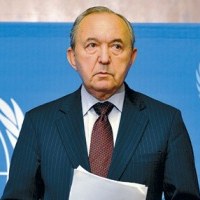




Latest Comments
Hello Mike, Thank you for your positive feedback to the article. I felt there wasn’t too much critical analysis of ...
Thanks for this considered and well constructed article. A follow up article on the manner in which the editorial contro...
THE CLUELESSNESS OF CLAIMING THAT OBAMA'S MIDDLE EAST POLICIES WERE A FAILURE CANNOT BE FURTHER FROM THE TRUTH, WHAT THE...
As long as Obama is the president of the usa do not trust the us government......
Thank you for an good read....